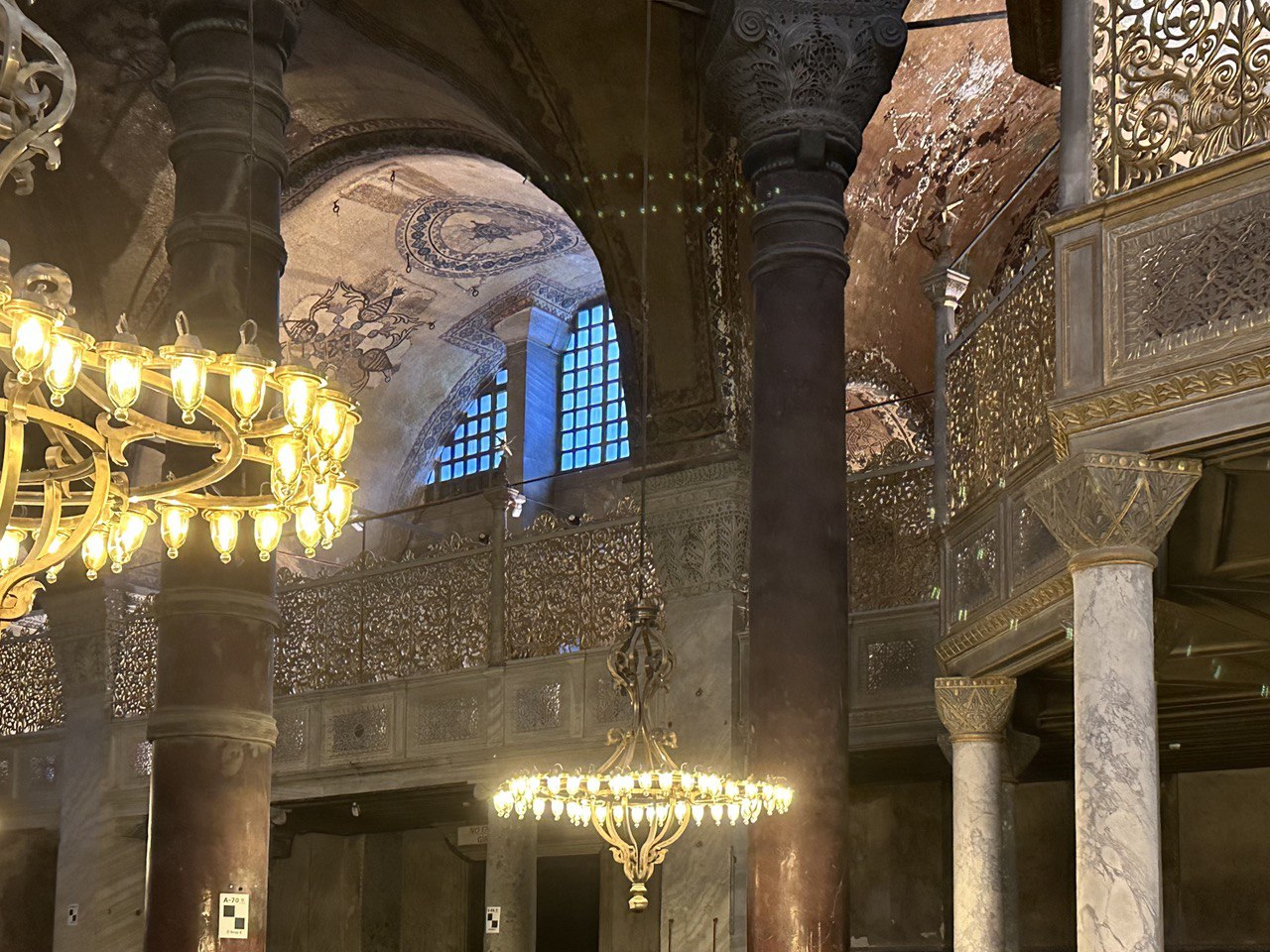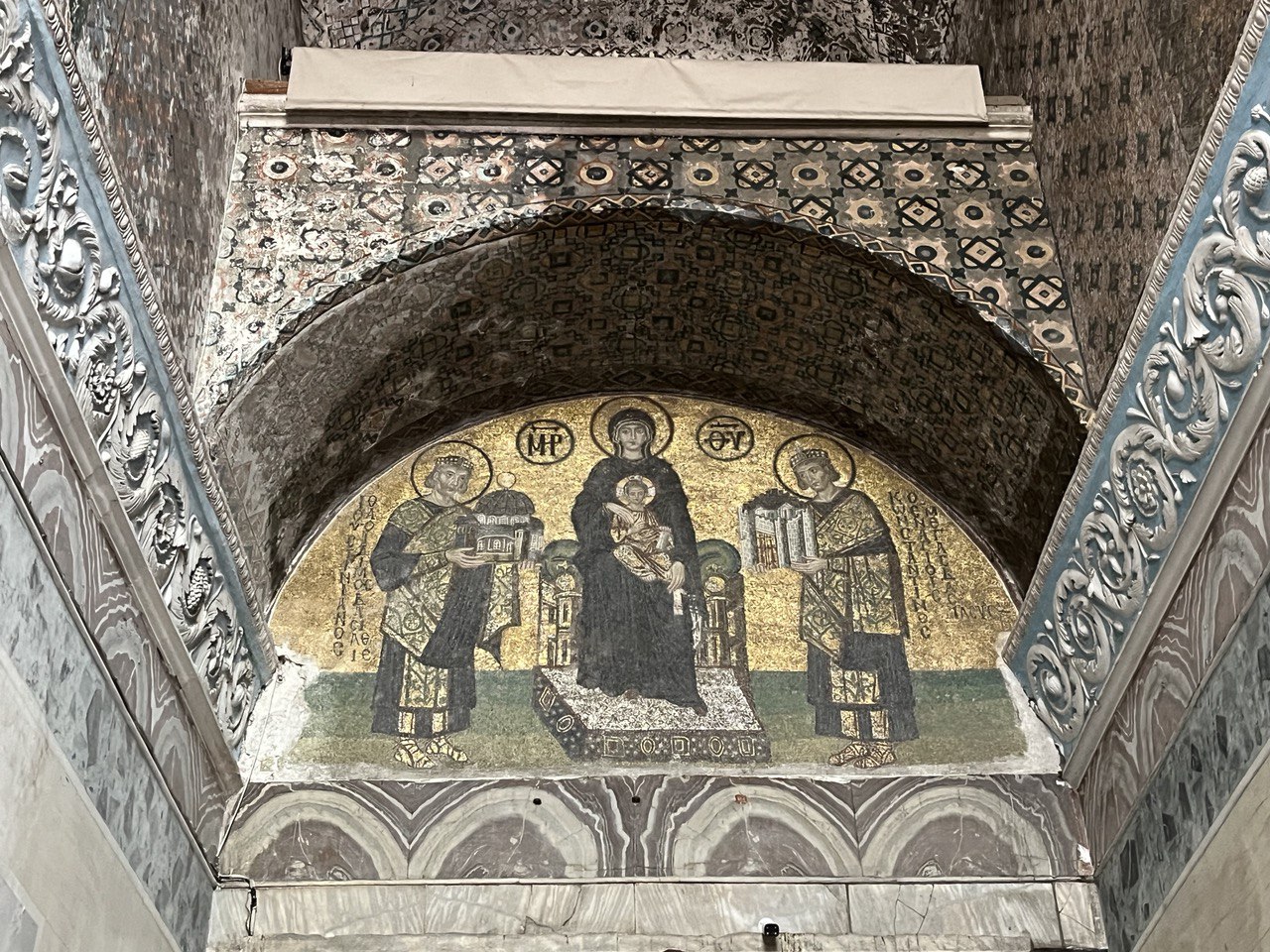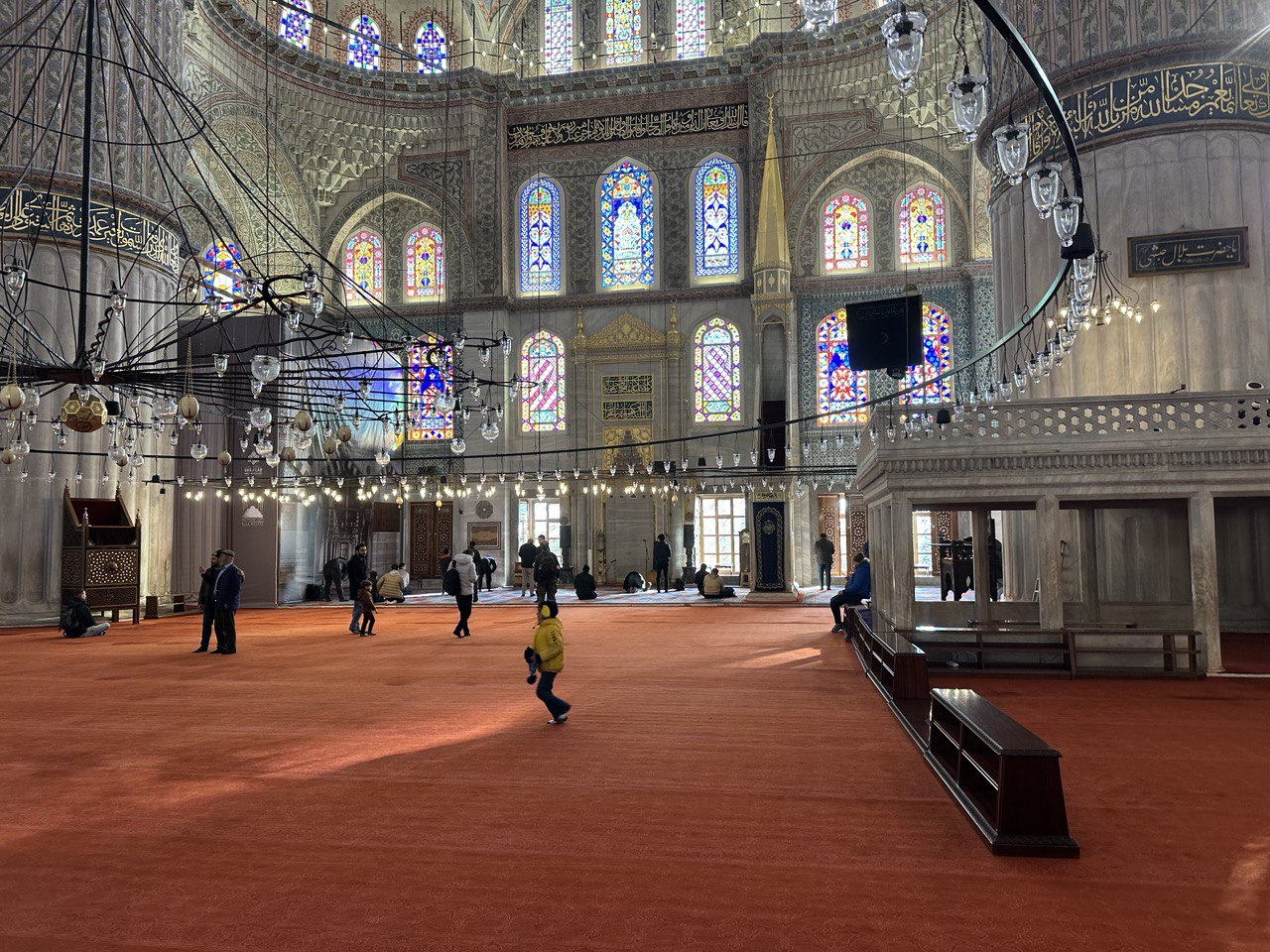Istanbul was the most popular destination from the Sochi airport in 2023. Since the beginning of the year, airlines have transported over 370 thousand people, which is almost 60 percent of the total passenger traffic to Turkey. For a long time, the large Turkish metropolis was perceived only as a point for a comfortable transfer, but today, it is also attractive for recreation. It is really worth visiting, even if there is very little time before the connected flight. Our correspondent shares with us what attractions to see in Istanbul during a one-day tour of the city and not regret going sightseeing.
Hagia Sophia

Hagia Sophia (St. Sophia Cathedral), the largest Christian Cathedral, museum and an operating mosque, is the main attraction in Istanbul that is a must-see. The first question many tourists ask about Hagia Sophia is “Why is it so rundown?” It’s simple. Built as a Christian Cathedral in the 6th century A.D., the building remained the largest in the world for a thousand years.
So, why should anyone think about external decoration if everyone is amazed by the cathedral’s size anyway? There’s a reason that Emperor Justinian decided to build a huge cathedral in Constantinople. When he came to power, a rebellion broke out that was suppressed and 35,000 of the rebellion supporters were put to death. By building the largest Christian Cathedral in the world, Justinian decided to show both the growing power of the religion and his own power. The construction of the gigantic cathedral, 55 meters high, took six years only, and 10,000 workers, 50 foremen and two architects were employed.

Surprisingly, the huge cathedral was built without a building frame, entirely from bricks. The Byzantines knew a lot about the art of construction; they mixed volcanic dust and pollen into the mortar that set and held the stones together. Now, scientists say that it is these components at the molecular level that allow the building to ‘vibrate’, saving it from numerous earthquakes.

They didn’t pinch money on decorating the Church of Hagia Sophia and three annual budgets of Byzantium and one of Egypt were spent. At that time, it was not the quantity of marble that was particularly valued, but its diversity. In the Church of Hagia Sophia, one can see 10 types of this stone, and its red columns were made of porphyry, which no longer exists in nature. The ceiling of the building was decorated with a mosaic of three millimeters of glass and three millimeters of braid gold. Of course, little of that wealth has survived to our time. However, the Osmanli Turks who came to Constantinople in 1453 are not to blame for this. All the most valuable things were taken out of the Church of Hagia Sophia by the crusaders 200 years before the Osmanli Turks. The Church of Hagia Sophia turned into the Hagia Sophia mosque; at the beginning of the 20th century when the Turkish Republic was established, it became a museum, and it was recently returned to Muslim believers. Nevertheless, there is much that amazes with its grandeur even today. Behind the white places on the ceiling, visitors can see a golden mosaic of the Virgin Mary. Seraphs have also been preserved on the walls; according to Muslim traditions, their faces are covered with iron masks.
The huge shields - seven meters in diameter - with inscriptions in Arabic are amazing. The names of Allah, the Prophet Muhammad and Companions of the Prophet are written on them. There were reasons to make large shields. Muslims believe that literally in a year, Jesus will come to the Earth again, and first of all, naturally, he will go to Hagia Sophia. He will not be able to enter the cathedral where the name of Allah is, which means Hagia Sophia will remain a mosque. Like any mosque, when the entry to it was free, it was better to arrive around 9 a.m., as later on, there were so many people wanting to come into Hagia Sophia, that the entrance was simply closed and there was a long queue. It was planned, that from January 2024 Hagia Sophia also operates as a museum and admission will be by tickets only. But it is not clear how they are going to separate the tourists from the believers.
Blue Mosque

The Blue Mosque is directly opposite Hagia Sophia on Sultanahmet Square. Its official name is the Sultanahmet Mosque (Sultanahmet Camii), actually, the square is famous for this mosque.
Sultan Ahmed was the great-grandson of the great Sultan Suleiman under whom the Ottoman Empire reached its peak. He was also the son of the very cruel Mehmed the Third who killed 19 of his brothers to gain the throne. This was done according to the Fatih law, when the new Sultan was obliged to ‘remove’ all possible competitors. Ahmed abolished this law. While he was more merciful than his father, he was not as great as his great-grandfather because Ahmed lost wars one after another. Then he decided to build a mosque so that the Almighty would support him in all his endeavors. It took 17 years to construct the mosque, and the result was a wonderful building of oriental architecture. The mosque was located above Hagia Sophia, which was supposed to emphasize the importance of Ahmed. The new mosque had six minarets. What’s unusual about it? The matter is that the number of minarets in a mosque should not exceed their number in the most important one that is located in Mecca. But Ahmed broke this rule. He justified himself just by saying that the architect misunderstood him, he told the architect that the minarets should be gold (in Turkish ‘alty’), but he thought that there should be six of them (‘altyn’ in Turkish). Although archival data says that Ahmed supervised the construction of the mosque and regularly visited it. Not to anger the Almighty, the Turkish Sultan found a way out and sponsored the construction of an additional, seventh minaret in the main mosque of Mecca.

The light comes inside the Blue Mosque through 260 windows and the Blue Mosque was decorated with more than 21,000 blue tiles, which contributed to its popular name - the Blue Mosque. Recently, the reconstruction has been completed and the mosque became not just blue, but more of pastel shades. In order to know why the mosque received its informal name, a sample of how it looked like remained on one of the columns. Considering that the Blue Mosque is an operating one, the tourists are not always allowed to visit it. The mosque is closed for tourists - who come not for praying - 45 minutes before the start of prayer and during 15 minutes after the prayer, as well as in every Friday morning until 2.30 p.m., when special religious services for Muslims are held. The last visitor is allowed to enter the mosque half an hour before it closes, that is, at 7 p.m. in summer and 5 p.m. in winter.
Basilica Cistern

Not far from Hagia Sophia is the entrance to one of the most unusual attractions in Istanbul. This is the Basilica Cistern. The story of its appearance is as follows. There lived a Turkish family, and their house was always rather damp and there was a mouldy smell. The owner of the house decided to see what was in the basement. He went down, saw the door, opened it, and there was a pond underground and fish swimming. He began to catch carp and treat his friends. Once he treated a French scientist to fried fresh-water fish, and the guest thought “Where does fresh fish come from in a city surrounded by the sea?” As a result, they found out the Basilica Cistern. What is it? To put it simply, it’s a huge underground pool built by order of Emperor Justinian. This was a strategic water supply for the entire city of Constantinople. Totally, about 40 such Cisterns were built in Istanbul, and not all of them have been found yet, because some home owners simply filled them with earth not to lose their property. All these underground pools were connected by a single water supply system and water was supplied through aqueducts from natural sources located 20 kilometers from present-day Istanbul. And all this system was made in the 4th-6th centuries A.D.

The Byzantines thought big. They believed they were best at making vaults and columns, that is why they wanted to build not just a basement underground, but a palace. And they built it, it was 140 by 70 meters (area 9.8 thousand square meters), 12 rows of columns, 28 in each row. Each column was eight meters high, but all were different. The Byzantines took them from various destroyed structures. The most elegant column was the ‘crying’ one. There are patterns on it like eyes through which water flows. The head of the Gorgon Medusa was the base of several columns, which looked as a symbol of the victory of the Christianity over paganism. And it took centuries to build all this under water - 80 thousand cubic meters. The fish were released into the unusual pool specifically to understand that the water was not poisoned by enemies. After the collapse of Byzantium, the cistern was abandoned for many years.

Enterprising Turks arranged romantic dates there and went boating. Since 1987, the Basilica Cistern has become a tourist attraction. Now, tourists can walk between the columns, feel the spirit of the times and admire popular installations, the price of the visit is 450 Turkish liras. It is worth mentioning that there is another cistern nearby, in Feodosia. It is smaller, but one can watch cartoons there.

Kadikoy District
After visiting all the main attractions of the Sultanahmet area, it is best to move to the Asian part of the city. To do this, travelers need to take a ferry to Kadikoy (Kadıköy) from the Eninonu (Eminönü) Pier. It is during this short 20-minute trip by a ferry along the Bosphorus Strait that travelers understand where the name Istanbul came from. The legend says that the Byzantine king Byzas received a sign from heaven one day he would build a city opposite the “Land of the Blind”. Byzas searched for this non-existent country for a long time and he got to the place one day where the Asian part of Istanbul is now located. In the morning, he looked out the window, saw the Bosphorus Strait’s water iridescent in the sunlight and asked why no one lived on the other side? The answer was simple - why? Then Bizas exclaimed “You are just blind” and founded a city, which later received the name Istanbul.

Sailing along the Bosphorus Strait travelers can see one of the symbols of the city, the Maiden’s Tower (Kız Kulesi), also known as Leander’s Tower, located on a small island. Since the 5th century, it served as a watchtower or as a tax point where duties were collected from ships passing through the Bosphorus Strait. The long white buildings along the coast are not palaces, but barracks. For many years, the Turkish army consisted of janissaries, essentially prisoners who became warriors. However, such soldiers were not effective, and in 1825, French mercenaries were recruited to join the Turkish army. To make their life more convenient, not only barracks, but also brothels were built for them. Perhaps, that is why Hemingway who visited Istanbul wrote that the center of ‘pleasure’ in the world is not Paris at all.

The ferry arrives at Kadikoy, the residential area. Walking through its streets, tourists are once again convinced that Istanbul is a city of contrasts. Here, between the market rows hung with dried eggplants and tomatoes and filled with olives of various colors and the smell of fresh fish, an Armenian Orthodox Church is located. Nearby, there is a Greek Orthodox Church. There is also a famous sweets shop decorated like a gingerbread cottage for the New Year and, of course, many colorful buildings - their pictures are very popular on social networks. And there are also a lot of people, therefore, after enjoying the noisy atmosphere of life, it is best to go to the embankment. It’s better to come there just before a sunset to understand why Istanbul is a city opposite the “Country of the Blind”.
In conclusion, here are some tips on how to visit Istanbul and not regret your trip:
1. From the new Istanbul airport, the most convenient way to get to the city is by Havaist bus. It takes just 40 minutes and costs about 400 rubles to go to Taksim Square from where Istiklal Avenue (İstiklâl Caddesi) - the busiest restaurant and shopping street - stretches towards the Golden Horn Strait (Haliç). There is also a metro line from the airport, but transitions are made with access to the street.
2. Public transport is well developed in Istanbul. Travelers need to buy an Istanbulcart, a transport card like the Moscow Troika card. The most convenient way to do this is at the yellow vending machines at tram stops. The best way to get to Sultanahmet Square and the main attractions is by tram T1. By the way, ferries in Istanbul are also considered public transport and are paid for by a card.
3. Über operates in Istanbul.
4. You should not look for a hotel in the Tarlabasi (Tarlabaşı) area, although this neighborhood is located very close to the tourist Istiklal Avenue. The Turks themselves do not risk entering this slum quarter.
5. In the Sultanahmet area, travelers can have their lunch or dinner at the Seafront Lounge, enjoying a view of the Bosphorus Strait. There are no crowds here like at the Seven Hills Restaurant that has gone ’viral’ on social networks, but there is a stunning panoramic terrace and delicious food. As for desserts, it is worth tasting ‘katmer ‘- thin dough with pistachio paste, as well as the famous ‘baklava’.
6. To see the amazing panoramic view of Istanbul, tourists don’t need to climb the Galata Tower and pay an entrance fee. Next to the tower, there is a delicious Firuzende Galata restaurant with panoramic windows where visitors can enjoy the view of the bay and the tower. Naturally, it is better to do this at sunset.
7. When visiting any mosque, shoes should be removed, and it’s recommended not to leave them at the entrance but take them with you. The Turks have a joke saying “I walked through the mosques of Istanbul on Friday, but couldn’t find a new Nike pair for myself.” This says a lot.


